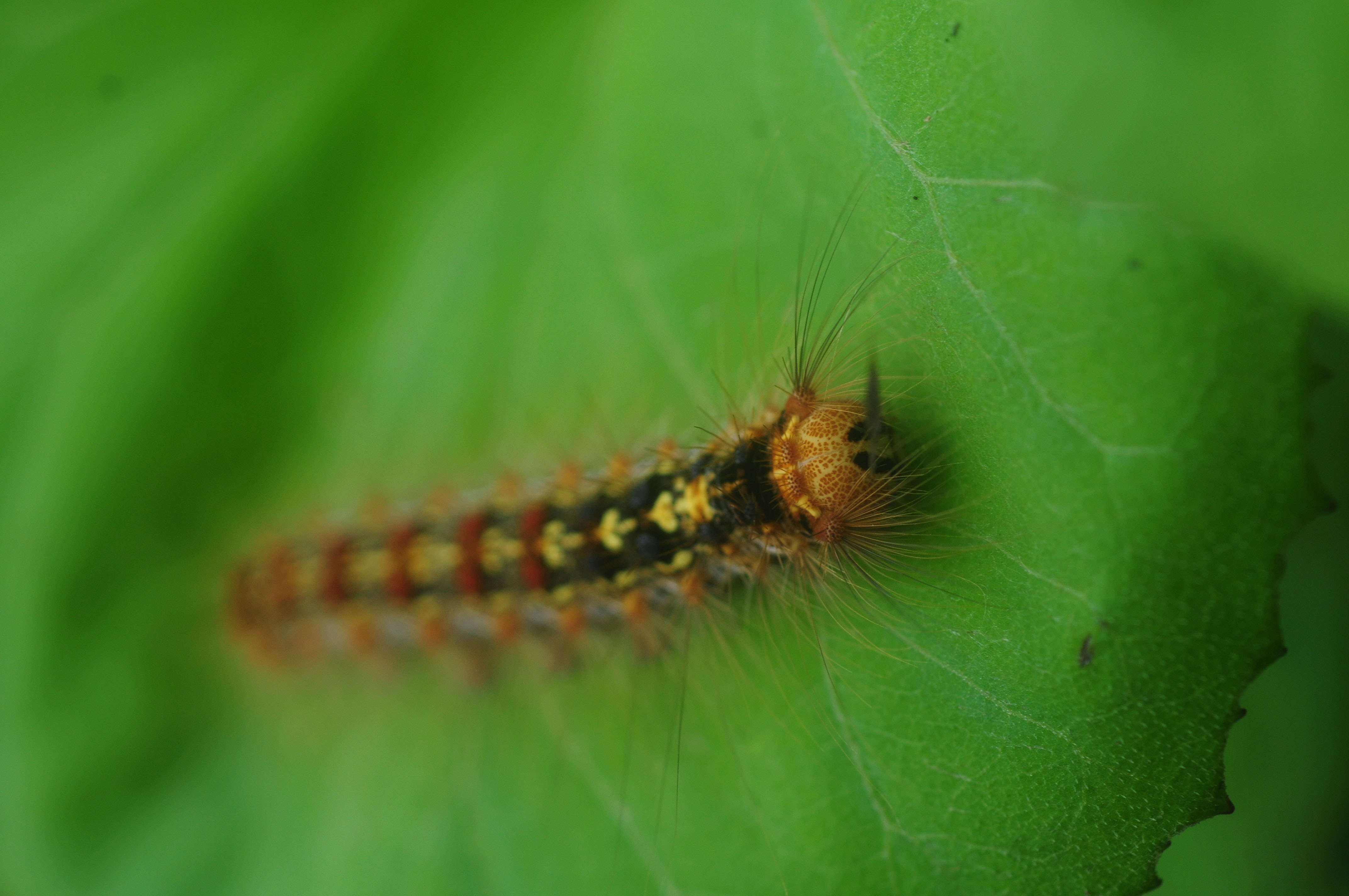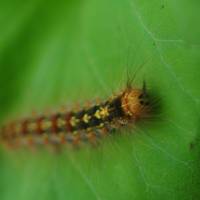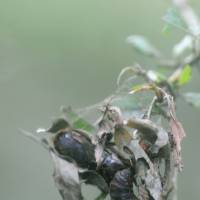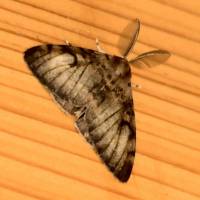Living in the countryside, the usual casual greetings include an observation about the weather, but for the last six weeks around my home in northern Nagano Prefecture, everybody mentioned the caterpillars. Now it's the moths. I've never seen such a plague of them in the 34 years I've been here.
When my eldest daughter, her husband and their 6-year-old twin daughters came to visit from Canada, I was on the road. I phoned my daughter to welcome them, and the first thing I said was: "Don't let the girls touch the caterpillars; the hairy ones — they're toxic!"
And no, I wasn't just being a fuss-pot, because my granddaughters will pick up and closely inspect anything, whether it be a frog, earthworm, snail, insect, spider, fish or whatever — and if we don't watch them, they'll even grab live snakes.
So, on the phone I went on to explain that those hairy caterpillars were the larvae of the gypsy moth (Lymantria dispar japonicus) — known as maimai ga in Japanese. The early stages of the larval state can give you a nasty rash, and you certainly don't want to get the hairs in your eyes or up your nose.
When the tiny larvae first emerge in spring, they spin long threads of fine silk and wait for the slightest puff of a breeze to lift them up and whisk them off. Once they get into foliage they munch away and become very active caterpillars, molting several times as they grow to reach between 4 and 5 cm long. By then they are brown with red and blue spots and long tufts of hair. In Europe they are sometimes called "tussock moths" because of those tufts.
This year the caterpillars have attacked oaks, beeches, chestnuts, Japanese dogwoods, magnolias, blueberry bushes and coniferous larches, stripping many trees totally bare of greenery and leaving others with tatty patches of disfigured leaves.
In fact there have been so many of the things that, standing under the big chestnut tree in front of our Afan Woodland Centre, we could actually hear them munching away in their thousands — while fragments of green leaves were strewn over the ground as if in a nightmare autumn.
Meanwhile, walking in the woods you could hear their droppings pitter-patter like rain — I kid you not! Park a car under trees and you'd return to find its roof totally spattered with caterpillar poo — which then, with a little rain, will smear and go all gooey. And, as another party piece, the bigger caterpillars also descend on silken lines like insect special forces rappelling from helicopters.
In Japanese, caterpillars are usually called kemushi (hairy bugs), but because of this habit of coming down on lines, country folk often refer to these ones as buranko mushi — which means, "swing bugs."
I'm generally not bothered by bugs as long as they don't bother me, but I hate these things. One dropped down the back of my shirt as I was bringing in the groceries, and I had an itching, ugly rash for three weeks. Our parcel-delivery man also complained that he had to hose the mess off his truck tires every night.
There were millions of them in the woods, the bigger ones climbing on the tree trunks in hordes. I personally have not seen a bird or anything else preying on them, but my expert staff claim there are many creatures that do, including a species of shield-bug beetle that sticks in its proboscis and sucks out their innards. Fortunately, too, a great many of the caterpillars began to shrivel and die, having apparently contracted a lethal virus.
Around seven weeks after the caterpillars hatch in spring from eggs laid by female moths the previous year, they finally change into dark pupae, surrounded with a silken net.
Then, after a couple of weeks, comes the final stage; for the last 10 days, the adult male moths, which are brownish with black markings, have been flying around everywhere. They swarm at night to the lights of convenience stores, stations, wherever. Open a door and in they'll come. There were even some fluttering about on a train I took the other day from Kurohime to Nagano.
As a boy, I used to think that moths were nocturnal. Yet right now as I'm writing this in the early afternoon, there are hundreds of male moths whirling and zig-zagging outside, each with its feathery antennae designed to pick up the females' alluring scent. At rest, these males would be shaped a bit like a triangle about 2 cm across and in length. However, the only stationary ones I've seen have been copulating or dead. What a way to go. Incidentally, neither the males nor the females eat, but apparently they can drink water.
In contrast to the males, the females — which are white with black markings — stay close to where they emerged from the pupa, attaching themselves to a tree, a rock, a wall, under the eaves of buildings; all over the place.
From there they pump out pheromones to bring the seemingly erratically flying males to them. Then they mate and the female lays a mass of eggs, light brown or tan in color and protected with a silken net that can give you a nasty rash if it gets on your skin. That net normally protects the eggs through winter unless there are some really cold spells — which I hope there will be before next spring.
The gypsy moth is endemic to Japan, Asia and Europe. Information on the Internet tells us that the species was introduced to North America from Europe in 1868 by a French naturalist who was trying to cross them with native species to create a more disease-resistant hybrid for the silk industry. However, some of the aliens escaped and spread, and ever since then gypsy moths have been extending their range and doing untold billions of dollars of damage to forests, orchards, gardens and parks. I won't give the poor man's name here, but that is an awful way for a naturalist to get remembered in history! You'd think he would have just run off to join the Foreign Legion.
Nowadays, ships from Japan can be refused entry to foreign ports if the egg masses of gypsy moths are found among their cargo or on their superstructure, which is tough for captains and shipowners because the bright lights of a port and ships in dock attract the moths in their millions.
Recently I wrote to my friend, the artist and naturalist Robert Bateman, telling him of our gypsy moth woes. He replied saying that on Saltspring Island in British Columbia, where he lives, there was a plague of the same moths some years back, leading to some whole trees being stripped bare.
Cautioning that it wasn't advisable to spray insecticides in the woods (which we would never do anyway), he predicted that after a couple of years a natural balance would be restored and the trees would recover. In the meantime, lots of friends here in Kurohime have been spending hours each day picking the caterpillars off their blueberry bushes by hand. Yuck!
However, after writing this article but before returning to my study to give it a final check and send it off, I took some guests through our woods. To my delight, I saw that several trees which had been totally stripped of foliage by the caterpillars were sprouting tiny new leaves. Robert was right!
In my experience, I've found that most Japanese women and girls find butterflies attractive, but dislike moths. My wife will shriek and wave her arms about, claiming that moths shower dust (presumably the scales from their wings?) onto everything. In the last couple of weeks, experiencing her antics first hand, anyone would have thought Attila the Hun was at the door.
Last month I was polishing off a novel, a comedy, in which the leading character is an eccentric, alcoholic British professor who gets divorced by his Japanese wife because his life's work is research into moths. In the novel he fell in love with her because she looked great in a kimono, and he began his study with jolly old Bombyx mori — the domesticated silkmoth.
Does this all portend something? Perhaps I'd better lay off the single-malt whisky and stick to shōchū tonight.






















With your current subscription plan you can comment on stories. However, before writing your first comment, please create a display name in the Profile section of your subscriber account page.